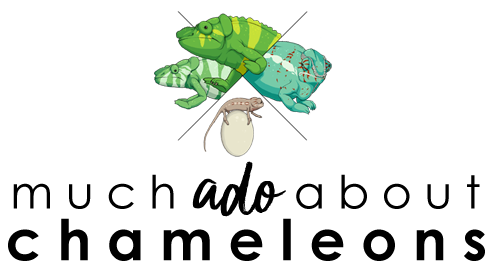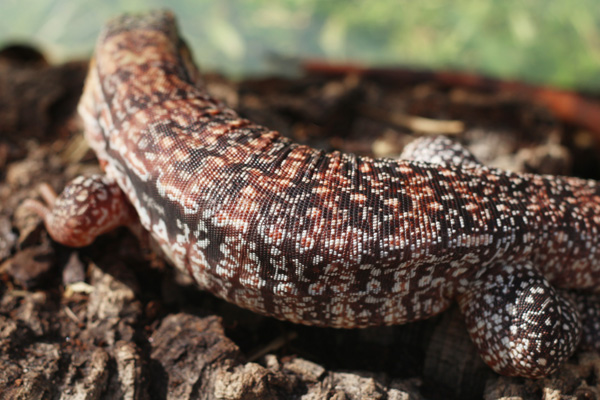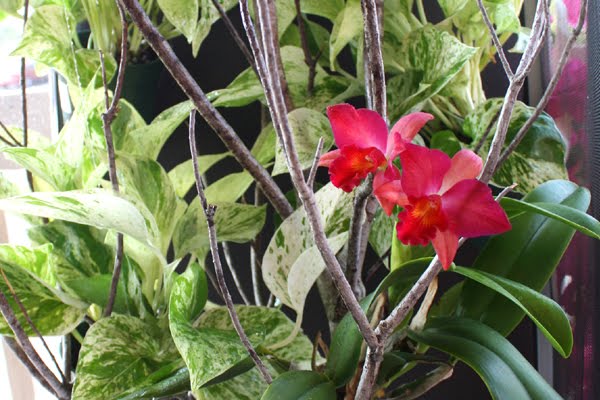In the several years that I've been keeping chameleons, I've come to see a few products as invaluable to how I care for my pets. There are a few products that I find I could not live without at this point if for some reason I couldn't get them any more! Thinking back on it, I can't remember how I found it easy or comfortable to care for them before, especially as I added more chameleons into my home. They usually make my life easier AND make the lives of my chameleons better.
This list may continue to change as I discover new products or as new, better products come out. But for now these are my favorites.
AUTOMATED MISTING SYSTEM
Product: Mistking Starter Misting System
Available: http://www.mistking.com/
Price: $99.00 + shipping
Mistking makes several models of increasing strength, to serve keepers with a few cages (with the starter system, like mine) or with entire green houses with the Advanced System. The Starter System pump can mist up to 20 cages, which is more than enough for most people, who like me may only have 10 or fewer cages to mist. However, the starter system only comes with one nozzle, so each additional one is about $14. This system also comes with a timer that can be set to mist from a few seconds to hours, so I can set it to mist several times a day for lengths between 5-15 minutes at a time and not have to worry about being home to mist my chameleons at a reliable, predictable schedule. This allows me to be in class, out doing errands, or spend the day at the beach and not worry about running home because my chameleons need water. This is a huge life-saver for anyone who is a full-time student or works full-time. Additionally, this system can run dry without ruining it. So for people who are very busy and forget to fill up the reservoir one day, they will not come home to a burnt out pump at night. Accidents happen, we forget, and it's nice to have a system that allows for that.
And most importantly, Marty, the owner of Mistking, is a fantastic man and is always ready to answer questions or provide customer support. I've had an e-mail conversation with him at 2am, trying to figure out what nozzles were right for me while doing a late-night study session, and he was there willing to give me information. I highly recommend it, it is worth every penny!
DIETARY SUPPLEMENTS
Product: Repashy Calcium Plus ICB
Available: http://www.pangeareptile.com/store/ (available in many other websites as well.)
Price: $7.99
Repashy makes a lot of my favorite products, so his name will come up again. I love this product because it is an all-in-one supplement. This is great because instead of having to provide plain calcium at most feedings, and then calcium with vitamin D3 or multivitamins a couple times a month, you can use this product every day and have it be your only mineral and vitamin supplement. This takes out the need to follow a monthly schedule with supplements and certainly makes life easier by only needing one product. It is fairly new to chameleons but the results so far are great.
Product: Repashy SuperCal No D3
Available: http://www.pangeareptile.com/store/ (available in many other websites as well.)
Price: $4.99
This is just a plain phosphorous-free, vitamin D3-free calcium that is great. Even though I use the Calcium Plus product, I like to supplement with extra calcium every few days a week, especially for my females. For anyone who does not want to use the Calcium Plus instead of the separate supplement method, I highly recommend this calcium as your plain calcium supplement because it contains no phosphorous - and this is important because phosphorous and calcium have to be in a 1:1 ratio within the body, but crickets are 3:1 phosphorous:calcium. So with a plain calcium like this, you can even out the ratio and have a more balanced animal, nutritionally.
GUT-LOADING & FEEDER NUTRITION
Product: Repashy Superload Insect Gut Load
Available: http://www.pangeareptile.com/store/ (available in many other websites as well.)
Price: $5.99
This powdered dry insect gut-load is great, because it provides me with a lot of the nutrition my insects need to be excellent food for my chameleons if I do not have time to grind up anything of my own. This, in conjunction with fresh fruits and vegetables, allows my insects to have a well-rounded diet so that they are healthy and full of good food when it's time to be fed off to my chameleons. Repashy also makes a gel food called Bug Burger that is also good because it is both wet and dry food in one, but I do not feel that it lasts me as long and it takes maybe 10 minutes to prepare and then a little while to cool into a gel. Not that this is terrible, but I prefer this one that is ready to go so I can shake in a little, throw in some fresh fruit, and get on with my day if I am busy with exams.
Product: DinoFuel
Available: http://www.kilgourschameleons.com/products.asp
Price: $13.99 (free shipping)
This product is fantastic as well. Essentially, it is powdered super foods that are very healthy for human consumption so they are great for our feeders. This takes the effort out of going to the health food market and picking out all these ingredients yourself and grinding them up, but it still provides those great foods. I will usually mix this as gut-load with the Superload or dust the feeders in it directly, as if it were calcium. Also, Tom is a fantastic guy and will answer any questions about his product or work out a deal for higher quantities of DinoFuel. The insects go nuts for it as well, so I highly recommend getting at least one package of it to try out!
ADDITIONAL TIPS AND Products
Product: 30-50lb Fishing line
Available: Any fishing, sports, or general goods store.
Price: $4.00
Why do I love fishing line? Because I can never have too many uses for it in screen cages. A heavy weight, clean fishing line with thread through the screen on cages without ruining it and it can be used to secure branches, vines, plants, or anything else you need. I use it to hang all my plants off of the cage floor or to secure things like the thermometer/hydrometer to the front of the cage so I can read the display. And because it's clear you don't see it unless you're looking for it, so it's a great way to discretely tie things together or secure others without having a cage covered in zip-ties.
Product: Air-tight Food Containers
Available: General good stores or kitchen supply stores.
Price: $4.00+ each
I love these little jars for storing my supplements and gut load. Instead of having to fumble with those little baggies, I have them in safe, sealed, air-tight containers that won't let the products to bad early. And they look much neater! The labels are made by me on the computer.
Product: Hefty storage containers
Available: For now, Target and Home Depot
Price: $5.00+
I find these phenomenal. The way the lid and the edge of the bin overlap keeps my insects from escaping, particularly any roaches that are capable of climbing smooth surfaces. Plus I find them very sturdy, appropriately sized, and aesthetically acceptable. My roach colonies seem to be doing very well in these!
Additional products and tricks to come!
9
 |
| Female carpet enjoying the mist from her Mistking system. |
AUTOMATED MISTING SYSTEM
Product: Mistking Starter Misting System
Available: http://www.mistking.com/
Price: $99.00 + shipping
Mistking makes several models of increasing strength, to serve keepers with a few cages (with the starter system, like mine) or with entire green houses with the Advanced System. The Starter System pump can mist up to 20 cages, which is more than enough for most people, who like me may only have 10 or fewer cages to mist. However, the starter system only comes with one nozzle, so each additional one is about $14. This system also comes with a timer that can be set to mist from a few seconds to hours, so I can set it to mist several times a day for lengths between 5-15 minutes at a time and not have to worry about being home to mist my chameleons at a reliable, predictable schedule. This allows me to be in class, out doing errands, or spend the day at the beach and not worry about running home because my chameleons need water. This is a huge life-saver for anyone who is a full-time student or works full-time. Additionally, this system can run dry without ruining it. So for people who are very busy and forget to fill up the reservoir one day, they will not come home to a burnt out pump at night. Accidents happen, we forget, and it's nice to have a system that allows for that.
And most importantly, Marty, the owner of Mistking, is a fantastic man and is always ready to answer questions or provide customer support. I've had an e-mail conversation with him at 2am, trying to figure out what nozzles were right for me while doing a late-night study session, and he was there willing to give me information. I highly recommend it, it is worth every penny!
 |
| My well used Mistking Starter System. Couldn't manage without it! |
Product: Repashy Calcium Plus ICB
Available: http://www.pangeareptile.com/store/ (available in many other websites as well.)
Price: $7.99
Repashy makes a lot of my favorite products, so his name will come up again. I love this product because it is an all-in-one supplement. This is great because instead of having to provide plain calcium at most feedings, and then calcium with vitamin D3 or multivitamins a couple times a month, you can use this product every day and have it be your only mineral and vitamin supplement. This takes out the need to follow a monthly schedule with supplements and certainly makes life easier by only needing one product. It is fairly new to chameleons but the results so far are great.
Product: Repashy SuperCal No D3
Available: http://www.pangeareptile.com/store/ (available in many other websites as well.)
Price: $4.99
This is just a plain phosphorous-free, vitamin D3-free calcium that is great. Even though I use the Calcium Plus product, I like to supplement with extra calcium every few days a week, especially for my females. For anyone who does not want to use the Calcium Plus instead of the separate supplement method, I highly recommend this calcium as your plain calcium supplement because it contains no phosphorous - and this is important because phosphorous and calcium have to be in a 1:1 ratio within the body, but crickets are 3:1 phosphorous:calcium. So with a plain calcium like this, you can even out the ratio and have a more balanced animal, nutritionally.
 |
| Two supplements I couldn't live without. Calcium Plus and Supercal, both by Repashy. |
Product: Repashy Superload Insect Gut Load
Available: http://www.pangeareptile.com/store/ (available in many other websites as well.)
Price: $5.99
This powdered dry insect gut-load is great, because it provides me with a lot of the nutrition my insects need to be excellent food for my chameleons if I do not have time to grind up anything of my own. This, in conjunction with fresh fruits and vegetables, allows my insects to have a well-rounded diet so that they are healthy and full of good food when it's time to be fed off to my chameleons. Repashy also makes a gel food called Bug Burger that is also good because it is both wet and dry food in one, but I do not feel that it lasts me as long and it takes maybe 10 minutes to prepare and then a little while to cool into a gel. Not that this is terrible, but I prefer this one that is ready to go so I can shake in a little, throw in some fresh fruit, and get on with my day if I am busy with exams.
Product: DinoFuel
Available: http://www.kilgourschameleons.com/products.asp
Price: $13.99 (free shipping)
This product is fantastic as well. Essentially, it is powdered super foods that are very healthy for human consumption so they are great for our feeders. This takes the effort out of going to the health food market and picking out all these ingredients yourself and grinding them up, but it still provides those great foods. I will usually mix this as gut-load with the Superload or dust the feeders in it directly, as if it were calcium. Also, Tom is a fantastic guy and will answer any questions about his product or work out a deal for higher quantities of DinoFuel. The insects go nuts for it as well, so I highly recommend getting at least one package of it to try out!
 |
| Rapashy Superload and DinoFuel, excellent food for insects. |
Product: 30-50lb Fishing line
Available: Any fishing, sports, or general goods store.
Price: $4.00
Why do I love fishing line? Because I can never have too many uses for it in screen cages. A heavy weight, clean fishing line with thread through the screen on cages without ruining it and it can be used to secure branches, vines, plants, or anything else you need. I use it to hang all my plants off of the cage floor or to secure things like the thermometer/hydrometer to the front of the cage so I can read the display. And because it's clear you don't see it unless you're looking for it, so it's a great way to discretely tie things together or secure others without having a cage covered in zip-ties.
Product: Air-tight Food Containers
Available: General good stores or kitchen supply stores.
Price: $4.00+ each
I love these little jars for storing my supplements and gut load. Instead of having to fumble with those little baggies, I have them in safe, sealed, air-tight containers that won't let the products to bad early. And they look much neater! The labels are made by me on the computer.
 |
| All my supplements and gut loading products (specified above) in their little acrylic and bamboo food containers. |
Product: Hefty storage containers
Available: For now, Target and Home Depot
Price: $5.00+
I find these phenomenal. The way the lid and the edge of the bin overlap keeps my insects from escaping, particularly any roaches that are capable of climbing smooth surfaces. Plus I find them very sturdy, appropriately sized, and aesthetically acceptable. My roach colonies seem to be doing very well in these!
Additional products and tricks to come!










































